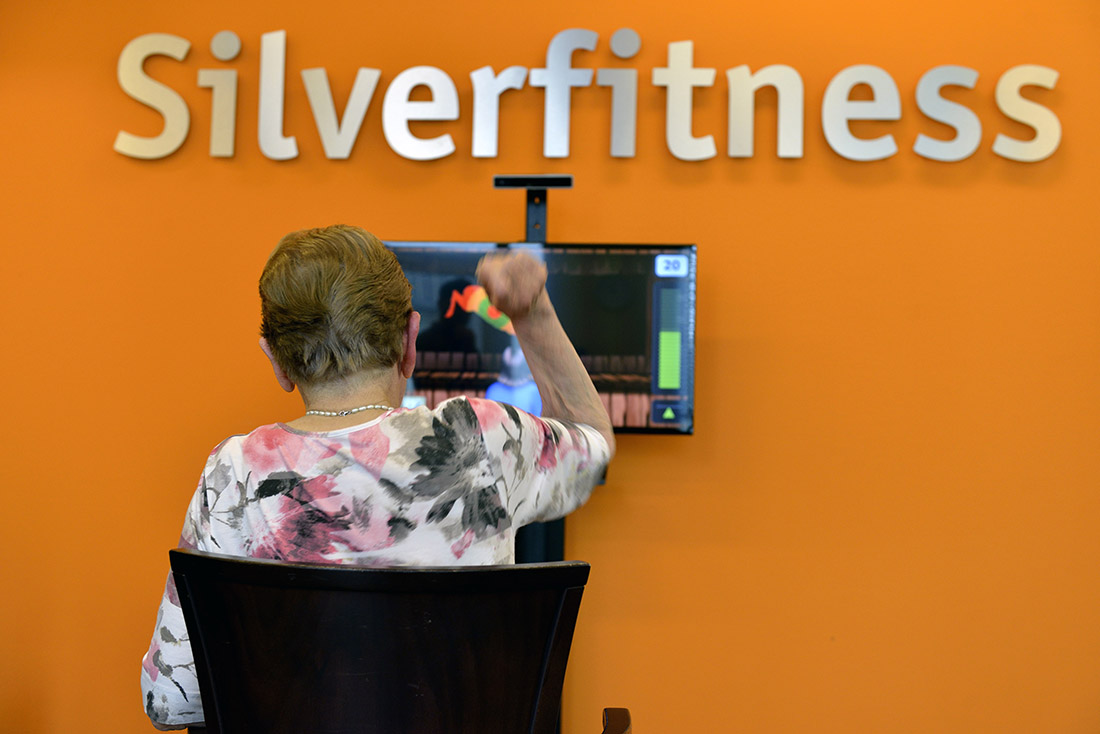Evidence based

Motor learning and feedback
These following elements are of interest for learning motor skills during treatment (Stroke 2014 Guideline by KNGF):
- the exercise should be tailored to the client
- the exercises must have sufficient repetition
- verbal and non-verbal feedback must be given on implementation
- the motivation to learn should be increased by informing the client of the purpose, by coaching and by giving (positive) feedback
Motivation
A review by Holden (2005) shows that games enhance the motivation of the client. This allows the client to practice longer and much more often, without it being experienced as a burden. The continuous feedback from the games enhances motivation. This includes both direct feedback (am I doing well or not) as well as insight into long-term performance improvement.

Therapy adherence
Rhodes et al. (2009) showed that exercising with video games leads to higher therapy adherence than exercise without video games. The research shows that higher therapy adherence is caused because participants have more fun training with video games than without. Lohse et al. (2013) described that video games lead to voluntary participation, extension of practice time and a high possibility of repeating the exercise. These factors increase motivation and could once again contribute to greater therapy adherence.
Intrinsic motivation is high when using SilverFit
In cooperation with Leiden University Medical Centre (LUMC) we examined levels of motivation when using the SilverFit. This showed that rehabilitation patients especially experienced intrinsic motivation; they trained not to achieve something, but because they enjoyed it. This type of motivation usually leads to the highest compliance. The therapists also indicated that the SilverFit caused more enthusiasm and more movement during therapy sessions (Oudheusden, 2013).
Balance and mobility
Darekar et al. (2015) wrote a review on the effect of virtual therapy on balance and mobility after a stroke. The results of the review showed that interventions with virtual therapy had significant positive effects on dynamic balance, walking speed and waking quality in comparison to interventions without virtual therapy.
Silverfit exercise is the best balance game
At the University of Trondheim in Norway, Skjaeret et al. (2014) compared three different games to train balance. One of those games was a SilverFit game, the mole game. The study looked at 5 movement aspects of balance. Of the three games that were tested, the mole game scored best on all aspects. The mole game also scored highest on the System Usability Scale (SUS; Nawaz et al. 2014).

Fall prevention protocol on SilverFit
Van Gastel & van der Burgt (2012) developed a fall prevention protocol for the SilverFit with the goal of improving balance, gait and muscle strength in the lower extremities. After a period of 6 weeks in which 1-hour training sessions with the SilverFit took place twice a week, they saw progress in the results of each participant for tests such as the Timed Up & Go, the Berg Balance Scale, and the Timed Chair Stand test. The fall prevention protocol is one of the protocols that are included in the SilverFit.
Encouraging exercise in the ward
In the study of Van Wijngaarden (2014), one of the goals was to increase the number of training moments for the geriatric orthopaedic rehabilitant to two moments daily of 20 to 30 minutes. These training moments occurred at the physiotherapist’s and in the ward under the direction of caregivers and occupational therapists. After a period of 6 weeks, the percentage of clients that trained 2 times a day increased from 0 to 60%.
Literature
- Braam, M. (2014). Een nieuwe output voor het mollenspel: Een onderzoek naar fysieke parameters geschikt voor het waarnemen van vooruitgang van spelers en te registreren zijn tijdens het mollenspel. The Hague University of Applied Sciences, unpublished BSc-thesis work
- Darekar, A., McFadyen, B.J., Lamonagne, A. & Fung, J. (2015). Efficacy of virtual reality-based intervention on balance and mobility disorders post-stroke: a scoping review. Journal of NeuroEngineering and Rehabilitation, 12:46
- De Deugd, J., Willemse, J. & Rademaker, R. (2010). SilverFit virtual reality game as an evaluation tool for hip function. Avans University of Applied Sciences 2010, poster publication in Brussel
- Faatz, T., Kerstens Y., Sipkes, N. & van Wensveen, R. (2015). Hoe serieus is serious gaming? Avans University of Applied Sciences, unpublished BSc- thesis work
- Griswold, D., Rockwell, K., Killa, C., Maurer, M., Landgraff, N. & Learman, K. (2014). Establishing the reliability and concurrent validity of physical performance tests using virtual reality equipment for community-dwelling healthy elders. Disability and Rehabilitation, 37(12):1097-1101
- Holden, M.K. (2005). Virtual environments for motor rehabilitation: review. Cyberpsychology & Behavior: The Impact of the Internet, Multimedia and Virtual Reality on Behavior and Society 8, no. 3: 187-211; discussion 212-9
- Lohse, K., Shirzad, N., Verster, A., Hodges, N. & Van der Loos, M. (2013). Video games games and rehabilitation: Using design principles to enhance engagement in physical therapy. Journal of Neurologic Physical Therapy, 37:166-175
- Nawaz, A., Skjaeret, N., Ystmark, K., Helbostad, J.L., Vereijken, B. & Svanaes, D. (2014). Assessing senior's user experience (UX) of exergames for balance training. In Proceeding of NordiCHI, pp. 578-587
- Rhodes, R.E., Warburton, D.E.R. & Bredin, S.S.D. (2009). Predicting the effect of interactive video bikes on exercise adherence: an efficacy trial. Psychology, Health & Medicine, 14 (6), 631-640
- Richtlijn Beroerte (2014). Koninklijk Nederlands Genootschap voor Fysiotherapie (KNGF)
- Skjaeret, N., Nawaz, A., Ystmark, K., Dahl, Y., Helbostad, J.L., Svanaes, D. & Vereijken, B. (2014). Designing for movement quality in exergames: lessons learned from observing senior citizens playsing stepping games. Gerontology, online first: 1-9
- Van Gastel, M. & van der Burgt, R. (2011). Verminderen van vallen met de SilverFit. Fysiotherapie & Ouderenzorg, 26(1): 11-17
- Van Oudheusden, P. (2013). Virtual reality in de ouderenrevalidatie. University of Applied Sciences Leiden, unpublished MSc-thesis work
- Van Wijngaarden, J. (2013). Kan therapeutisch gamen gebruikt worden als extra trainingsmoment bij de geriatrische orthopedische revalidant? Avans Plus University of Applied Sciences, unpublished MSc-thesis work
 Nederlands
Nederlands  English
English  Français
Français  Deutsch
Deutsch 






